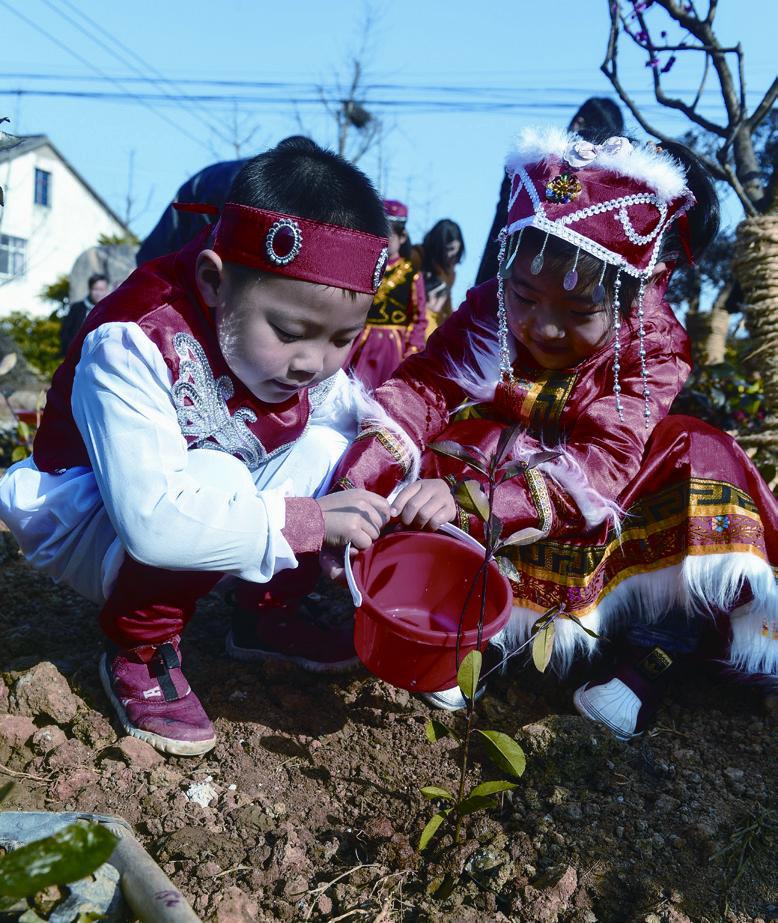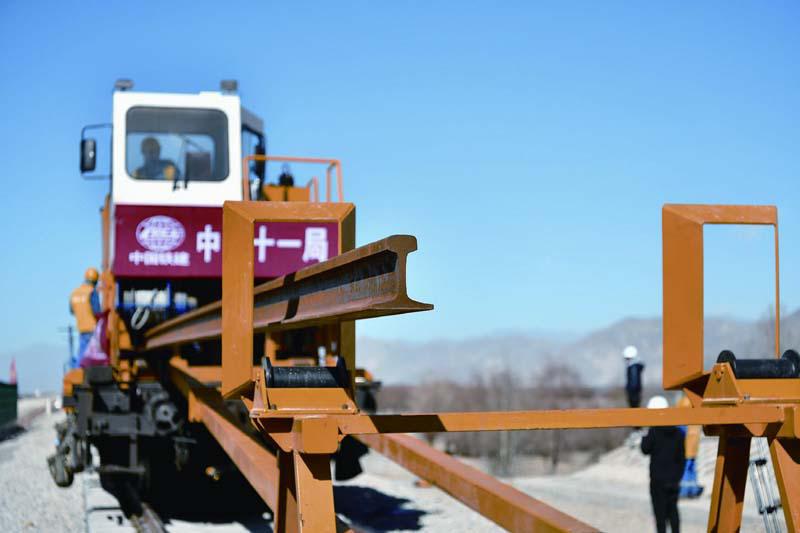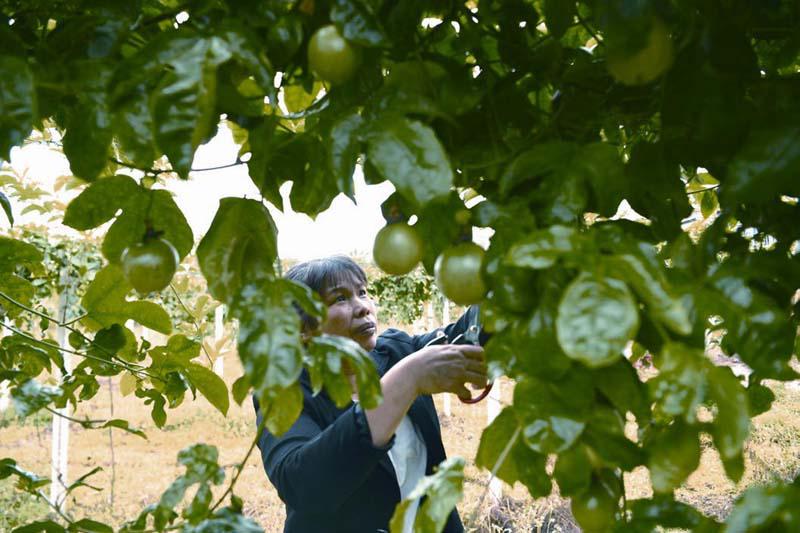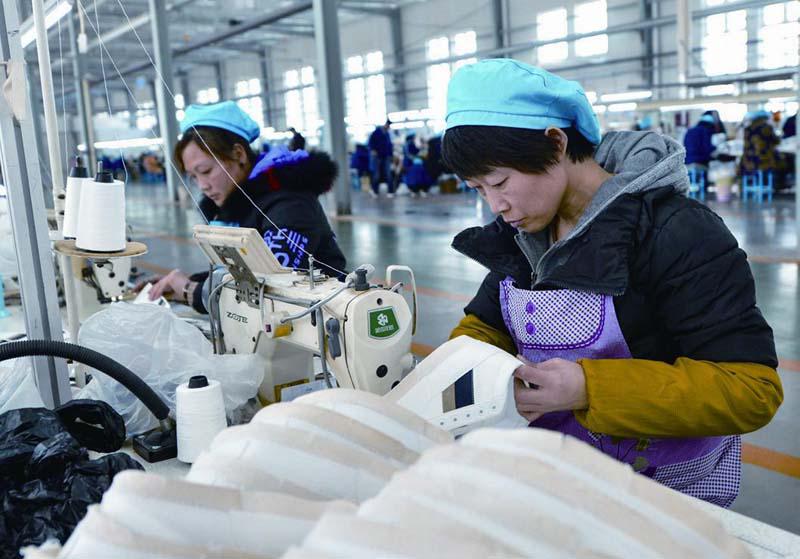Diving Deep
2019-03-27
Diving Deep
Chinas science ship Tansuo-1, loaded with the manned submersible Shenhai Yongshi (Deep Sea Warrior), returns to its home harbor in Sanya, south Chinas Hainan Province on March 10, after fi nishing its fi rst expedition in the Indian Ocean. The 121-day expedition, organized by the Chinese Academy of Sciences, involved scientists from 10 Chinese and foreign research institutes.
Legal Aid for Women
About 361,000 women in China received legal aid in 2018, accounting for 24 percent of the total number of aid recipients, the Ministry of Justice announced.
Judicial authorities at all levels and legal aid institutions around the country made women their work priority with targeted efforts to provide timely, precise and convenient services, the ministry said.
They expanded their services to cover more items that are closely related to the protection of womens rights and interests, including marriage, education, medical service and abuse, according to the ministry.
Authorities and institutions built legal aid work stations and contact sites to improve the legal service network and make it more convenient for women to seek legal aid.
They also used public legal service platforms and hotlines and dispatched specialist lawyers to offer quality legal services for women, it said.
AI Courts
Chinese courts will use artifi cial intelligence (AI) in trials and the administering of court verdicts in 2019, as part of efforts to improve services and advance the building of smart courts, according to the Supreme Peoples Court (SPC) on March 11.
Xu Jianfeng, Director of the SPC Information Center, said that courts will use in-depth applications for electronic fi ling and advance mobile electronic litigation and establish mobile micro courts, allowing intelligent applications to cover all aspects of trials.
In terms of building smart courts, courts will focus on precise execution, constructing holograms of people on trial and linking with the social credit system.
At the same time, combined with face recognition technology, courts will improve integrated services and establish a database to provide identity verifi cation services and share information on citizenship, lawyers, enterprises and judges.
The China Judgements Online website, one of the countrys public judicial platforms, has unveiled over 60 million judgment documents and received more than 20 billion visits.
Pension Insurance
China is capable of ensuring full and on-time payment of retirement pensions even after reducing business contributions to social insurance schemes, a senior offi cial said on March 12.
According to repeated calculations, the income for social security funds will still be greater than spending despite a decrease in the share borne by employers for urban workers basic pension insurance, Zhang Jinan, Minister of Human Resources and Social Security, said on the sidelines of the annual legislative session.
Zhang said that Chinas nominal enterprise contributions to social insurance schemes are comparatively high and have some room for reduction.
“Lowering the share of employers for urban workersbasic social insurance can vitalize fi rms to expand production and employment, thus introducing more insurance payers and creating a bigger social security fund pie to form a virtuous circle and enhance the mechanisms sustainability,”Zhang said.
The reduction of enterprise contributions to social insurance schemes is part of Chinas broader efforts to ease companies fi nancial burden by further cutting taxes and fees for them.
In addition to a strategic stock of about 2 trillion yuan ($297.9 billion) in national social security funds, China also has about 4.78 trillion yuan ($712.8 billion) in an enterprise social insurance fund, representing a rather strong guarantee, Zhang added.
Efforts will be stepped up to replenish social security funds through the injection of state capital, he said.
China has decided to continue to increase the basic retirement pension in 2019, the 15th consecutive year of a pension increase.
Malformation Aid
The National Health Commission said on March 11 that fi nancial aid will be provided to more children and minors with congenital malformations this year.
The program, f rist launched in 2017 to help impoverished patients, will be expanded to cover 31 provincial regions across the Chinese mainland, according to a circular from the commission.
Under the program, patients aged 18 and under from households with economic diffi culties will be eligible for subsidies, which range from 3,000 yuan ($446) to 30,000 yuan ($4,464).
Offi cial data show that more than 200,000 newborns show visible clinical malformations at birth in China annually, with most being structural congenital disorders.
In comparison, a total of 15.23 million children were born in China in 2018.
A Tree Grows
Children from different ethnic groups, in their traditional clothes, plant a sapling at a kindergarten in Hongqiao Town, east Chinas Zhejiang Province, on March 12, which is Tree Planting Day.
Red Tourism
China has stepped up efforts to promote “red tourism,” which features visits to sites with signifi cant revolutionary history, said the Ministry of Culture and Tourism.
More revolutionary museums will be open to the public for free and more creative cultural products of revolutionary relics will be developed, said the ministry.
Meanwhile, red tourism sites are encouraged to increase cooperation with surrounding schools, Communist Party of China(CPC) committees and government institutions, to attract more students and Party members to learn about the countrys revolutionary history.
China has 33,315 revolutionary sites and relics on record. Statistics show that more than 800 million red tourism trips are made on average every year.
In recent years, red tourism has gained great popularity in China. In the city of Jinggangshan in east Chinas Jiangxi Province, the center of early revolutionary activities of the CPC, tourists visit places where revolutionary fi gures once lived and worked.
In the fi rst 10 months of 2018, Jinggangshan received more than 10 million tourists, generating tourism revenue of more than 10 billion yuan ($1.49 billion), up almost 10 percent year on year, according to local government fi gures.
Anti-Porn Review
Chinese authorities urged online service providers to take stricter measures to deal with pornographic content on their platforms in order to create a better online environment for the countrys youth.
The National Offi ce Against Pornographic and Illegal Publications issued a statement saying that efforts to manage the safety of online content are not only a legal obligation but also a social responsibility for Internet businesses, according to a report by the China Press Publication, Radio, Film and Television journal.
The statement called on social network platforms, search engines, and short video and live broadcasting websites that have vast numbers of young users to adopt stricter standards and measures in managing the content on their platforms to earnestly perform their duties. The offi ce pledged enhanced efforts in supervision and in handling reports from the public, saying it will work with other authorities to strictly punish those who produce, upload or spread pornographic content online.
A Healthy Punch
A martial arts instructor teaches students Zhaquan, a type of Chinese boxing, at a primary school in Xingtai City, north Chinas Hebei Province, on March 11. In a bid to preserve traditional culture and improve studentsphysical fi tness, the art has been promoted in local schools.
House Renovations
China has made substantial progress in renovating dilapidated houses in rural areas, said the Ministry of Housing and Urban-Rural Development.
Over 6 million registered poor households have seen their rundown houses renovated since the country launched the “three tough battles” against major risks, poverty and pollution in November 2015, the ministry said.
In 2018 alone, 1.57 million registered rural poor households saw their dilapidated houses renovated, according to the National Bureau of Statistics.
China plans to renovate another 15 million units of shanty houses from 2018 to 2020 to speed up its urbanization drive and improve peoples lives.
Industrial Internet
China will establish a standard system for the industrial Internet by 2020, according to a guideline jointly released by the Ministry of Industry and Information Technology and the Standardization Administration.
By integrating information technology and the manufacturing industry, the industrial Internet will have a comprehensive and profound infl uence on industrial development, the document said.
It added that the industrial Internet combines the Internet, platforms and security, constituting the Internet infrastructures that connect people, devices and things.
To fulfi ll the 2020 target, China will focus on formulating technical standards for crucial elements of the industry, including Internet resource management and industrial big data.
The country plans to formulate more than 100 standards and build a more integrated and open standard system by 2025, the guideline said.
Precise Positioning
A construction machine lays track for the Lhasa-Nyingchi section of the Sichuan-Tibet Railway in southwest Chinas Tibet Autonomous Region on March 8. The new line will be the second railroad into Tibet after the Qinghai-Tibet Railway.
Trade Growth
The growth in Chinas foreign trade of goods rebounded strongly after the week-long holiday of the Spring Festival, or the Chinese Lunar New Year, according to a senior customs offi cial on March 9.
Imports and exports surged 21 percent year on year from the middle to the end of February, Ni Yuefeng, head of the General Administration of Customs (GAC), said.
In the fi rst eight days of March, the countrys foreign trade soared 24.7 percent year on year, with exports rising nearly 40 percent.
Historical data show that its a normal phenomenon to have fl uctuations in monthly statistics for the month that coincides with the Spring Festival, Ni explained.
The GAC said on March 8 that Chinas foreign trade fell 9.4 percent year on year in February to 1.81 trillion yuan ($270 billion), raising concerns about a slowdown in the worlds second largest economy.
Analysts cautioned that it was diffi cult to compare trends in Chinas data at the start of the year due to the effect of the Spring Festival holiday, which came in early February this year, on business activity.
Deducting the Spring Festival factor, Chinas foreign trade rose 10.2 percent year on year in February, with exports increasing 7.8 percent and imports rising 12.9 percent.
NEV Sales Up
With both production and sales continuing to expand, the newenergy vehicle (NEV) market in China remained vigorous in February, a bright spot amid the lackluster automobile sector.
About 52,900 NEVs were sold in February, up 53.6 percent year on year, the China Association of Automobile Manufacturers (CAAM) said on March 11. Production also saw rapid expansion, with an over 50-percent increase.
China has intensifi ed efforts to promote the use of NEVs to ease pressure on the environment, offering tax exemptions and discounts on car purchases. The government also encouraged carmakers to build more NEV factories and improve technology.
For years, China has remained the worlds largest NEV market, with around 1.26 million cars sold in 2018.
CAAMs data also showed that the broader automobile sector maintained a downward trend in February as total sales decreased 13.8 percent from a year ago and 37.4 percent from January. Production also declined.
Chen Shihua, an assistant to secretary general of CAAM, attributed the drop in part to the week-long Spring Festival holiday in early February.
Better Profitability
Chinas coking industry reported rising production and improving profi tability in 2018, offi cial data showed.
Coke output totaled 438 million tons, up 0.8 percent year on year, reversing a decline of 3.3 percent registered in 2017, according to the Ministry of Industry and Information Technology (MIIT).
The sector posted its highest profi tability in years, lifted by a surging demand in steel last year, the MIIT said.
The ministry took the northern province of Shanxi, a major coke production base in China which accounts for more than one fi fth of the countrys total output, as an example. Coking enterprises saw their 2018 business revenues and net profi ts surge 19.8 percent and 120.2 percent, respectively, year on year to 187.28 billion yuan ($27.85 billion) and 17.75 billion yuan ($2.65 billion), respectively.
The country exported 9.75 million tons of coke in 2018, up 20.8 percent from a year earlier, while the price per ton of exports climbed 14.3 percent to $304.9 on average, according to the China Coking Industry Association.
Fruitful Life
A villager prunes a fruit tree in Ningming County, south Chinas Guangxi Zhuang Autonomous Region, on March 6. E-commerce has become a key driving force for local economy, helping to increase the income of villagers.
Property Market
The total sales volume of Chinas top 100 real estate developers declined 22.9 percent month on month and 11 percent year on year in February, according to the China Real Estate Information Corp. (CRIC), an online industrial information provider.
The CRIC attributed the falling turnover to the unexpected cooling in the real estate market of thirdand fourth-tier cities.
The housing markets in the cities of Xuzhou, Huaian and other small cities, which are mainly driven by migrant workers who want to purchase property in their hometowns, saw a signifi cant drop in property sales, according to the CRIC.
Chinas real estate sector has been expanding at a slower pace in recent years due to government control measures. Property sales in value gained 12.2 percent in 2018, down 1.5 percentage points from the previous year.
Gas Market Boom
The demand for natural gas in China is expected to reach an 8-percent annual growth rate by 2030, a senior executive of a leading Chinese energy company said.
Hou Qijun, Vice President of China National Petroleum Corp., made the remarks during the Special Dialogue on China at the IHS Markits CERAWeek that kicked off in Houston, Texas, on March 11.
According to Hou, China is rapidly adjusting the energy structure, especially regarding the implementation of the Paris Climate Agreement. The current share of natural gas in the countrys energy mix is relatively low, estimated at 7 to 8 percent, with a future target of 15 percent.
Hou said that over the past few years, China has combined energy structure adjustment with air pollution control, by intensifying the coal-to-gas project and promoting clean energy heating.
According to offi cial statistics, Chinas imports of natural gas came in at 90.39 million tons in 2018, rising 31.9 percent year on year.
Making Change
Villagers from impoverished families make shoes at a company in Jize County, north Chinas Hebei Province, on March 9. Local enterprises have been encouraged to increase employment of people with fi nancial diffi culties as part of poverty alleviation efforts.
Green Aquaculture
China will promote the green devel- opment of its aquaculture industry and produce more eco-friendly aquatic products, according to the Ministry of Agriculture and Rural Affairs (MARA).
More than 98 percent of aquatic products will meet market standards by 2022, and ecological demonstrative zones are expected to account for 65 percent of the total aquaculture areas, the ministry said.
To achieve such targets, 10 government departments including the MARA have unveiled a guideline on the green development of the industry, vowing to build more demonstrative zones and advance ecological prevention of aquatic animal diseases.
While strengthening the planning of waters and shoals for aquaculture, China will make efforts to optimize the industrial structure and encourage deep-sea aquaculture.
The guideline also stressed that the country will improve the management of aquaculture waste and maximize the industrys role in ecological restoration.
